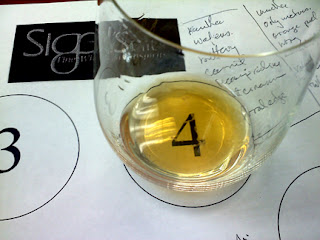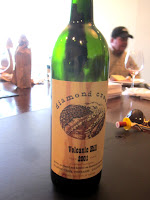A tasting seminar with Woodford Reserve Master Distiller Chris Morris raised the big question about branded spirits: where's the fine line between branded marketing and artisanal quality? Whisk(e)y producers from both Kentucky and Scotland love to cloak themselves in the aura of old traditional products, produced back in the hills for generation on generation. In truth, the modern distilleries in both countries have their roots firmly planted in the industrial revolution.
Mr. Morris was very up front with the issue. While there over 300 brands of Kentucky whiskey on the market, there are only 10 distilleries, a fact that is at odds with the current fascination with local and authentic sourcing. Mr. Miller emphasizes this fact since Woodford Reserve is a single brand that comes from a single distillery, leaving over 299 brands to come out of the remaining 9.
But Woodford is a young brand. It was the vision of Owsley Brown, chairman of Brown-Forman, the large (but family held) diversified producer of wines and spirits who saw the need for a super-premium Kentucky Bourbon. It was released in Kentucky in 1996. After four years, the market was expanded into neighboring states, then was released nationwide. Not exactly your grand-daddy's mythic whiskey.
So, when the clouds of marketing are swept away, how's the product? Pretty tasty. And for solid reasons that will ring true with artisanal authenticity.
Grain: 72% food grade #1 dimple yellow corn grown in Shelby County, Ky.,18% Dakota grown rye, 10% Milwaukee Malted Barley. Most Bourbon recipes use 5%. Malted Barley provides enzymes that help release the sugars.
Water: unfiltered limestone well water. No surface water which is required to be treated by the FDA.
Yeast: like most distilleries, they grow their own. However they only used a small amount of the sour mash and ferment twice as long as most distilleries to give a rich, flowery, fruity character to the beer.
Pot still: triple distillation utilizing three copper pot stills. The lower temperature of the pot stills brings more flavors through the distillation.
Maturation: Barrels are wine toasted before charring. The whiskey is proofed to 110 before barrel entry. Barrels are selected by flavor in lots of 100 for bottling. The last batch Chris bottled had dates ranging from Nov 2002 to March 2003 making the whiskey 8-9 years old.
They did their homework and made all the right-sounding decisions about putting a product together. How does it taste?
Complex aromas of vanilla wafers, butter, butterscotch, pralines, burnt orange and cinnamon are framed by floral perfumes. The whiskey is smooth and luxurious on the palate with notes of vanilla, honey, and butterscotch followed by spicy orange peel and caramel with anise highlights and a long finish with vanilla and white chocolate. Delicious by itself, dry enough to use for cocktails.
Saturday, March 26, 2011
Thursday, March 17, 2011
BT#7: Blind Leading the Blind
It's red.
It has a little age but not too much.
After that, it's anyone's guess. Ahh, we were a little better than that. It was a small group that gathered around the conference table on a recent Sunday afternoon to enjoy some wines. And taste them blind. No theme. Just bottles in brown bags or decanters. In the name of family and responsibility (???) we decided to keep it down to one bottle per participant, but there was question whether bottles of white or bubbles really counted.
The first wine showed pale gold straw and a delicate mousse that quickly subsided to a still presence in the glass. Showing subtle streaks of honey through racy minerals. Notions of champagne (and especially not THAT ONE Mr B!) were quickly dispelled by the lack of yeasty creaminess. The beams of honey reminded Corey of a Cremant Vouvray he had had recently and that's what it was. 2005 Petillant from Domaine Huet.
The first red wine had been open for about three hours with no decanting. It was opaque purple and obviously unfiltered. A plethora of perfumed aromatics filled the room. "It smells like my grandmother's dresser:" dried flowers and fruits, sachets, sweet-tarts and cinnamon. Plenty of structure, the palate showed mature fruits with finely integrated tannins. No signs of age, but obviously a wine with a youthful maturity and an old school style. Huge sediment left inside the bottle. Cabernet. Napa. 2001 Diamond Creek Volcanic Hill. Everyone was blown away. Most encounters with this legendary label are like making friends with a grizzly, the wine growls, lets you know it means business and you back off. But today we would tell tales of its opulent compassion.
The gauntlet was thrown down on the next bottle. "It's a tough one!" The bottle had been open for about an hour with no decanting. The wine was intensely black with deep red highlight and showed intense red and black fruits with a deep, dark center and a kiss of acid pulling up on the edges. Great stuff! Quickly dubbed European, Scott narrows the field to Spain. The grape is Tempranillo, but the point of origin is a stumper. Bodegas Mauro VS 2004. 100% Tempranillo, 33 months in French oak. Castilla y Leon is the region. It's similar to an IGT from Italy or Vin de Pays from France. A notch down on the 'quality name' ladder, but make not mistake, this is amazing wine. Castilla y Leon encompasses Ribuera del Duero, Toro and Rioja. Bodegas Mauro is located in the heart of the Duero valley.
Red Wine Number Three had been open and decanted for 90 minutes and showed a brilliant, vibrant dark purple color. Massive black fruits dominated the aromatics and followed through to the palate, complemented with highlights of cedar, red berries and a small stick of black licorice. Napa cab, but the group had a hard time determining the age of the wine. 1996 Chateau Montelena Estate Cabernet, now showing a bit of age! A second coup for old school Napa! Another wine with dark stains inside the bottle.
The fourth wine had been opened that morning and double decanted. Showing a dark, opaque purple color (hmm... another theme of the day) the wine showed rich cassis tinged with eucalyptus. Australian Cabernet? Perhaps the legendary eucalyptus monster itself: Penfolds Bin 707, 2004? Again, an older cabernet.
And the fifth wine is dark and opaque, but aromas, whoa, bring on the funk! Sheep are singing on the barnyard fence. Gamey notes of cedar and dried fruits begin to emerge on the long integrated finish. Big wine with plenty of grip. #4 signs on: Italian, Super Tuscan, Cabernet, 1995 Sammarco from Castello dei Rampolla.
What a day of old, serious wines. Interesting that all are Cabernets except for the Spanish Tempranillo, and the big ripe reds of the Duero are always fun to throw into Cab tastings.
Thanks to John who volunteered his company's conference room, to Dave for the bread and cheese and to Scott for pulling us all together. Can't wait for the next one. I'd be willing to bet everyone's already thinking about what to bring.
It has a little age but not too much.
After that, it's anyone's guess. Ahh, we were a little better than that. It was a small group that gathered around the conference table on a recent Sunday afternoon to enjoy some wines. And taste them blind. No theme. Just bottles in brown bags or decanters. In the name of family and responsibility (???) we decided to keep it down to one bottle per participant, but there was question whether bottles of white or bubbles really counted.
The first wine showed pale gold straw and a delicate mousse that quickly subsided to a still presence in the glass. Showing subtle streaks of honey through racy minerals. Notions of champagne (and especially not THAT ONE Mr B!) were quickly dispelled by the lack of yeasty creaminess. The beams of honey reminded Corey of a Cremant Vouvray he had had recently and that's what it was. 2005 Petillant from Domaine Huet.
The first red wine had been open for about three hours with no decanting. It was opaque purple and obviously unfiltered. A plethora of perfumed aromatics filled the room. "It smells like my grandmother's dresser:" dried flowers and fruits, sachets, sweet-tarts and cinnamon. Plenty of structure, the palate showed mature fruits with finely integrated tannins. No signs of age, but obviously a wine with a youthful maturity and an old school style. Huge sediment left inside the bottle. Cabernet. Napa. 2001 Diamond Creek Volcanic Hill. Everyone was blown away. Most encounters with this legendary label are like making friends with a grizzly, the wine growls, lets you know it means business and you back off. But today we would tell tales of its opulent compassion.
The gauntlet was thrown down on the next bottle. "It's a tough one!" The bottle had been open for about an hour with no decanting. The wine was intensely black with deep red highlight and showed intense red and black fruits with a deep, dark center and a kiss of acid pulling up on the edges. Great stuff! Quickly dubbed European, Scott narrows the field to Spain. The grape is Tempranillo, but the point of origin is a stumper. Bodegas Mauro VS 2004. 100% Tempranillo, 33 months in French oak. Castilla y Leon is the region. It's similar to an IGT from Italy or Vin de Pays from France. A notch down on the 'quality name' ladder, but make not mistake, this is amazing wine. Castilla y Leon encompasses Ribuera del Duero, Toro and Rioja. Bodegas Mauro is located in the heart of the Duero valley.
Red Wine Number Three had been open and decanted for 90 minutes and showed a brilliant, vibrant dark purple color. Massive black fruits dominated the aromatics and followed through to the palate, complemented with highlights of cedar, red berries and a small stick of black licorice. Napa cab, but the group had a hard time determining the age of the wine. 1996 Chateau Montelena Estate Cabernet, now showing a bit of age! A second coup for old school Napa! Another wine with dark stains inside the bottle.
The fourth wine had been opened that morning and double decanted. Showing a dark, opaque purple color (hmm... another theme of the day) the wine showed rich cassis tinged with eucalyptus. Australian Cabernet? Perhaps the legendary eucalyptus monster itself: Penfolds Bin 707, 2004? Again, an older cabernet.
And the fifth wine is dark and opaque, but aromas, whoa, bring on the funk! Sheep are singing on the barnyard fence. Gamey notes of cedar and dried fruits begin to emerge on the long integrated finish. Big wine with plenty of grip. #4 signs on: Italian, Super Tuscan, Cabernet, 1995 Sammarco from Castello dei Rampolla.
What a day of old, serious wines. Interesting that all are Cabernets except for the Spanish Tempranillo, and the big ripe reds of the Duero are always fun to throw into Cab tastings.
Thanks to John who volunteered his company's conference room, to Dave for the bread and cheese and to Scott for pulling us all together. Can't wait for the next one. I'd be willing to bet everyone's already thinking about what to bring.
Subscribe to:
Posts (Atom)



